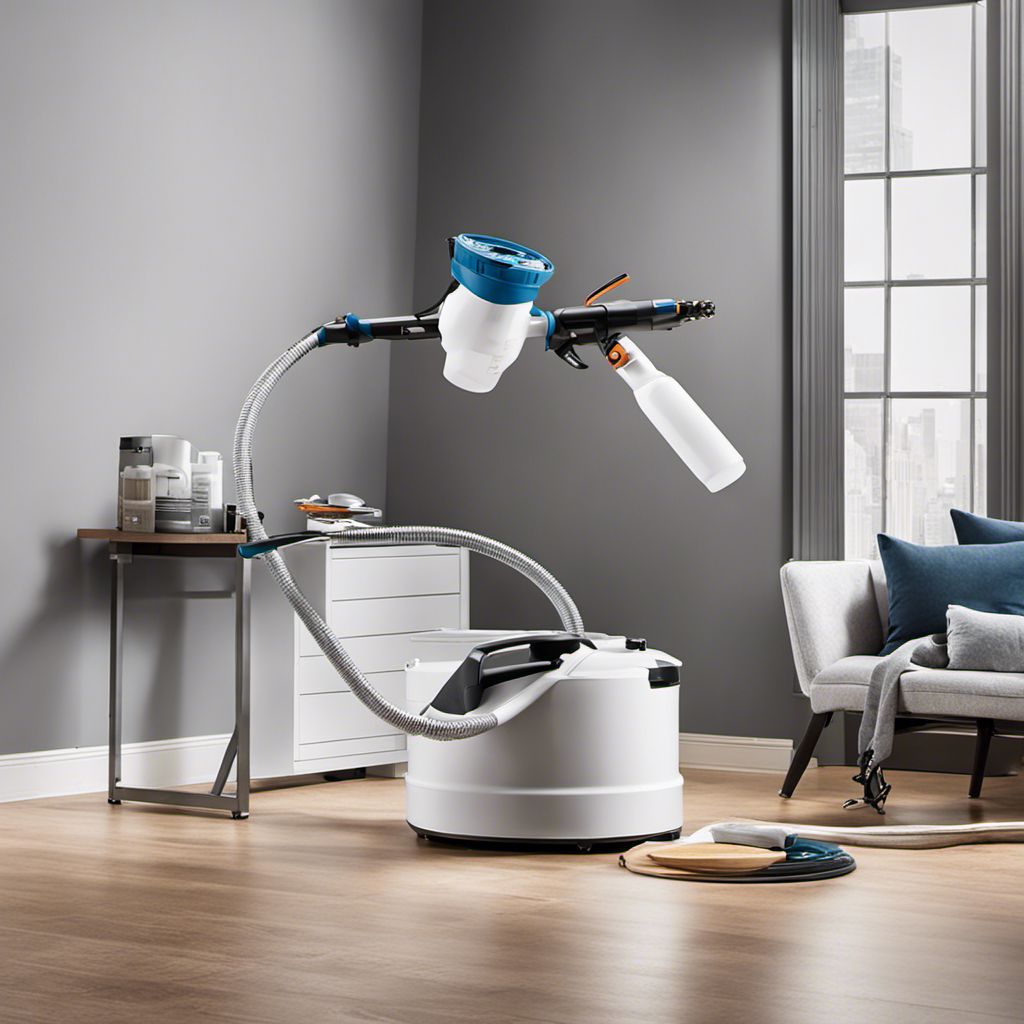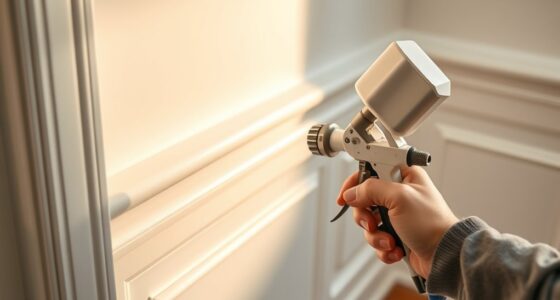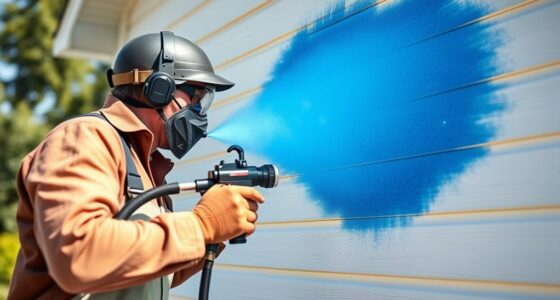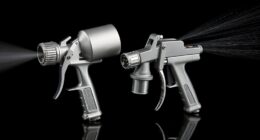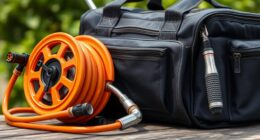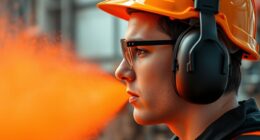Mastering the use of an airless paint sprayer can greatly impact the outcome of your paint job, resulting in a flawless finish. This innovative tool has revolutionized the painting process, making it quicker, simpler, and more effective.
With an airless paint sprayer, users can say goodbye to brush strokes and roller marks, and hello to a professional-looking finish. But, understanding the proper techniques, components, and maintenance of an airless paint sprayer is crucial.
In this article, we will explore the techniques and benefits of mastering the airless paint sprayer, so you can take your painting skills to the next level.
Key Takeaways
- Airless paint sprayers provide faster and easier painting with even coverage, making them efficient for large areas and thick coatings.
- Proper techniques for using an airless paint sprayer include holding the sprayer 12 inches away from the surface, moving in a smooth, continuous motion, overlapping each stroke by 50%, and maintaining a consistent distance from the surface.
- Airless paint sprayers use high pressure to atomize the paint, resulting in a fine mist that evenly covers surfaces and provides a professional finish without brush strokes or roller marks.
- Maintenance and troubleshooting of airless paint sprayers are important to ensure a successful painting job, including checking seals and gaskets regularly and troubleshooting common issues such as clogging, uneven spray pattern, and inconsistent pressure.
Choosing the Right Airless Paint Sprayer
When choosing the right airless paint sprayer, it is important to consider factors such as the size of the project, the type of coatings to be used, and the desired level of performance.
It is essential to choose a paint sprayer that is suitable for the specific requirements of the project. One must compare airless paint sprayers with HVLP sprayers to determine which one will be more effective.
Airless paint sprayers are known for their ability to handle larger projects and thicker coatings, making them ideal for commercial and industrial applications. On the other hand, HVLP sprayers are better suited for smaller projects and finer finishes.
Understanding the Benefits of Airless Paint Sprayers
The even coverage and professional finish achieved with an airless paint sprayer make it a popular choice for large painting projects. The benefits of using an airless paint sprayer include faster and easier painting, even coverage, efficiency for large areas and thick coatings, and a professional finish without brush strokes or roller marks.
However, there are also some drawbacks to consider. Airless paint sprayers can be expensive to purchase and maintain, and they can create significant overspray.
When comparing airless paint sprayers to HVLP paint sprayers, it’s important to note that airless sprayers are more efficient for large areas and thicker coatings, while HVLP sprayers are better for fine finishing work.
It’s important to weigh the pros and cons and consider the specific needs of your project before making a decision.
Mastering the Proper Techniques for Airless Spray Painting
To achieve smooth and consistent results, the painter should maintain a consistent distance of 12 inches from the surface when using an airless paint sprayer. Mastering spray gun techniques is essential to achieving a flawless finish.
The painter should hold the sprayer firmly and move it in a smooth, continuous motion, overlapping each stroke by 50%. This ensures even coverage and prevents any streaks or lines. Additionally, the painter should be mindful of the spray pattern and adjust the nozzle size accordingly to achieve the desired width.
Practice and experience are key to mastering these techniques and achieving professional results. With proper technique and attention to detail, the painter can create a flawless finish using an airless paint sprayer.
Exploring the Components of an Airless Paint Sprayer
Exploring the components of an airless paint sprayer, the painter should familiarize themselves with the motor, pump, hose, and gun. These components work together to ensure a smooth and efficient painting process.
The motor is the power source of the sprayer, providing the necessary force to atomize the paint.
The pump is responsible for pressurizing the paint and delivering it to the gun.
The hose acts as a conduit, connecting the pump to the gun.
And finally, the gun is where the paint is sprayed onto the surface.
When comparing different nozzle sizes for different painting projects, it is important to consider the width of the spray pattern and the amount of paint released. Choosing the right nozzle size can greatly impact the final result of the painting project.
Nozzle Selection and Spray Pattern Control
When selecting a nozzle size for an airless paint sprayer, the painter must consider the desired width of the spray pattern and the amount of paint to be released. Achieving precise coverage requires choosing the right nozzle size for the job. Nozzle maintenance is also crucial to ensure consistent and accurate spray patterns. The following table provides a guide for selecting the appropriate nozzle size based on the desired spray pattern width and the viscosity of the paint:
| Spray Pattern Width (inches) | Nozzle Size (thousandths of an inch) | Paint Viscosity (seconds) |
|---|---|---|
| Less than 4 | 0.009 – 0.011 | 15 – 25 |
| 4 – 6 | 0.013 – 0.015 | 20 – 30 |
| 6 – 8 | 0.017 – 0.019 | 25 – 35 |
| 8 – 10 | 0.021 – 0.023 | 30 – 40 |
| Greater than 10 | 0.025 – 0.027 | 35 – 45 |
Regular nozzle maintenance, such as cleaning and replacing worn or damaged nozzles, is essential for consistent and precise coverage. By properly selecting and maintaining the nozzle, painters can achieve professional results and ensure the longevity of their airless paint sprayer.
Troubleshooting Common Issues With Airless Paint Sprayers
The painter can troubleshoot common issues with their airless paint sprayer by identifying and addressing clogging, uneven spray patterns, and inconsistent pressure. Troubleshooting these problems is essential to ensure a successful painting job.
Here are four tips to help the painter troubleshoot their airless paint sprayer:
-
Clear paint clogs by removing the nozzle and soaking it in a cleaning solution.
-
Adjust the spray pattern by checking the nozzle size and adjusting it accordingly.
-
Check the pressure settings and adjust them to maintain a consistent pressure throughout the painting process.
-
Regularly inspect and clean the filters to prevent clogging and ensure smooth paint flow.
Essential Maintenance Tips for Your Airless Sprayer
Regular maintenance of an airless sprayer is essential for optimal performance and prevention of potential issues. This includes checking seals and gaskets regularly.
To maintain the airless sprayer, it’s important to follow a maintenance schedule. This schedule should include regular checks of the seals and gaskets to ensure they are in good condition and functioning properly.
Troubleshooting clogging issues is another important aspect of maintenance. Clogs can occur in the nozzle or the hose, and it’s important to address them promptly to prevent any interruptions in the spraying process.
Preparing Your Work Area for Airless Spray Painting
To ensure a smooth workflow and minimize accidents or mishaps, it is important for users to properly organize their work area before starting airless spray painting. Here are four protective measures to consider when organizing your work area:
-
Clear the work area of obstacles: Remove any furniture, decor, or other items that may obstruct your movement or get in the way of the spray.
-
Protect nearby furniture and floors: Cover furniture and floors with drop cloths or plastic sheets to prevent accidental splatters or spills from damaging them.
-
Clean and prepare the surface: Before painting, clean the surface thoroughly, removing any loose paint or debris. If necessary, apply primer to ensure proper adhesion.
-
Use proper ventilation: Ensure that the work area is well-ventilated to minimize the inhalation of paint fumes and promote a healthier working environment.
Surface Preparation Techniques for Optimal Results
By thoroughly cleaning the surface and removing any loose paint or debris, users can ensure optimal results when preparing for airless spray painting. Surface preparation techniques are crucial for achieving a smooth and long-lasting finish.
Before starting the painting process, it is important to assess the quality of the paint. Check for any signs of peeling or cracking, as these areas will need to be sanded and repaired before painting. Additionally, make sure the surface is free from dirt, grease, and other contaminants by washing it with a mild detergent and water.
Any imperfections should be filled and sanded to create a smooth and even surface. Taking the time to properly prepare the surface will ensure that the paint adheres well and results in a professional-looking finish.
Selecting the Perfect Paint for Your Project
When selecting paint for a project, it is important to consider factors such as color, finish, and durability.
-
Color psychology: The right paint color can evoke specific emotions and set the mood in a space. Warm colors like red and yellow can create a cozy and energetic atmosphere, while cool colors like blue and green promote calmness and relaxation.
-
Understanding paint finishes: Different paint finishes, such as matte, satin, and glossy, offer varying levels of sheen and durability. Matte finishes are ideal for hiding imperfections, while glossy finishes provide a sleek and polished look. Satin finishes strike a balance between the two.
-
Durability and longevity: Consider the durability of the paint to ensure it can withstand the wear and tear of daily life. Factors such as scrub resistance and fade resistance should be taken into account.
-
Personal preference: Ultimately, choose a paint color and finish that align with your personal style and taste. After all, you are the one who will be living with the finished result.
Diluting and Mixing Paint for Airless Spray Application
Mixing paint for airless spray application involves diluting the paint according to the manufacturer’s instructions to achieve the desired consistency. This step is crucial because the viscosity of the paint affects the spray pattern and coverage. Paint that is too thick can result in clogging and an uneven finish, while paint that is too thin may cause excessive dripping and overspray. To ensure the right consistency, it is essential to follow the recommended paint mixing techniques.
The table below outlines the importance of paint consistency and the corresponding outcomes:
| Consistency | Outcome |
|---|---|
| Too Thick | Clogging, uneven finish, poor coverage |
| Too Thin | Excessive dripping, overspray, lack of control |
| Just Right | Smooth application, even coverage, professional finish without drips |
Frequently Asked Questions
How Do I Clean and Store an Airless Paint Sprayer Properly After Use?
To clean and store an airless paint sprayer properly after use, follow these steps.
First, ensure that the sprayer is unplugged and the pressure relieved.
Then, disassemble the sprayer and clean each component thoroughly with water or a recommended cleaning solution. Pay attention to any clogs or buildup and remove them carefully.
Once cleaned, allow the parts to dry completely before reassembling and storing in a clean, dry area.
Proper cleaning and storage will prolong the lifespan of your sprayer and ensure optimal performance.
What Safety Precautions Should I Take When Using an Airless Paint Sprayer?
Proper safety precautions are essential when using an airless paint sprayer to ensure a safe and accident-free painting experience.
It is important to wear appropriate personal protective equipment, such as safety goggles, gloves, and a respirator, to protect against potential hazards.
Additionally, ensuring a well-ventilated work area and using necessary equipment, like a spray shield or tarp, can help prevent overspray and keep the surrounding environment safe.
Following safety guidelines, avoiding common mistakes, and being aware of potential hazards are crucial for a successful and safe painting project.
Can I Use an Airless Paint Sprayer for Detailed or Intricate Projects?
Yes, an airless paint sprayer can be used for detailed or intricate projects. It is commonly used for larger areas and thick coatings, but it can also be effective for smaller DIY projects. The key is to adjust the spray pattern and pressure settings to achieve more precision. It is important to practice on a scrap surface first to get comfortable with the sprayer and to maintain a steady hand. With proper technique and control, an airless paint sprayer can provide excellent results for both large and small painting projects.
What Is the Average Lifespan of an Airless Paint Sprayer?
The average lifespan of an airless paint sprayer depends on several factors, including the quality of the sprayer, frequency of use, and proper maintenance. By following recommended maintenance tips, such as regularly cleaning and lubricating the sprayer, checking for worn or damaged parts, and storing it properly, users can extend the lifespan of their airless paint sprayer.
It is important to consult the manufacturer’s guidelines for specific maintenance instructions to ensure optimal performance and longevity.
How Do I Choose the Right Tip Size for Different Types of Paint and Surfaces?
When choosing a paint sprayer tip size for different types of paint and surfaces, it’s important to consider a few factors.
Thicker paints, like latex or acrylic, require larger tip sizes to ensure proper atomization. For smoother surfaces, smaller tip sizes are recommended to achieve a finer finish.
Additionally, the desired spray pattern width should also be taken into account. Experimenting with different tip sizes and techniques will help determine the best fit for each specific project.
Conclusion
In conclusion, mastering the airless paint sprayer can lead to impeccable results and a professional finish. By understanding the benefits and techniques of this powerful tool, users can achieve even coverage and save time on their painting projects.
With proper maintenance and troubleshooting, the airless paint sprayer can be a valuable investment. Preparing the work area, selecting the right paint, and diluting it correctly are all crucial steps in ensuring optimal results.
So, seize the sprayer, spray with skill, and see the stunning strokes of color come to life!
Franz came aboard the Paint Sprayer Zone team with a background in both journalism and home renovation. His articulate writing style, combined with a passion for DIY projects, makes him an invaluable asset. Franz has a knack for breaking down technical jargon into easy-to-understand content, ensuring that even the most novice of readers can grasp the complexities of paint sprayers.
